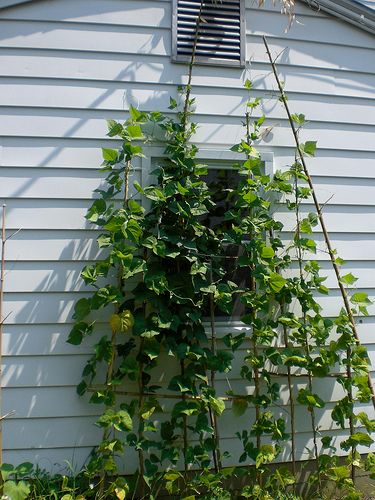
If you aren’t doing this with your veggies already, you’re missing out. Growing vegetables vertically saves space, time, and money. As an added perk, it also minimizes pests and disease for food crops such as cucumbers, pole beans, peas, squash, tomatoes, melons, and pumpkins. What should your veggies be climbing? You can break out your tools, some directions and begin construction.
But I’m always looking for the easiest route and think that the most logical structures to start with are the foundation or permanent (or semi-permanent) fencing in your yard or garden. Fencing that you already have on your property, is fair game as a support for vertical vegetables. For that matter, so are trellises, or arbors that were previously used for roses, clematis, or other ornamental plants.
The fencing that separates your property from your neighbor’s is a logical place to start when planning on gardening up. One way to utilize solid, wood-paneled fencing is by attaching hanging baskets, pots, and other growing containers to it. With this type of vertical garden, you wouldn’t be worrying about vegetable plants that climb, it would be about veggies and fruit that grow well in containers such as lettuce, radishes, strawberries, herbs, and the like.
Wood fencing made with flat boards doesn’t offer anything for climbing veggies to “grab” in order to hoist themselves up, but attaching a trellis or other grid-type material is a game-changer. Now, the tendrils and twiners have all the support they need. Some yards are surrounded by low, picket-type fencing. Fences that are constructed with both vertical or horizontal materials can be used as a home for climbing veggies. Hanging planters can also be secured to the top of this type of fence and still be within the gardener’s reach.
Chain-link fencing, while technically ugly, turns out to be undeniably useful as a vertical garden structure. It’s a climbing plant’s dream. Not to mention that when something with full foliage is planted against it, it’s transformed into an attractive “solid” wall. I’ve grown grape vines along our short, chain-link fence and I loved the look.
But heed my warning here: Most vegetable plants are going to be of the annual sort. Which means that the plant is going to die at the end of every season. Which means that you’ll be picking the dead, brittle, twining vines off and out of that chain link. Capische? Now, this information never stopped me, but I felt it was only fair to offer up the dirty details. By the way, the grape vines weren’t nearly as bad as the dead green bean vines.
Solid cement wall fences have an additional perk that most don’t; a flat, secure top. Rectangular planter boxes can be placed along the top of the wall for an instant vertical garden. Plant those boxes or troughs with peas and harvest the pods as they grow down instead of up.
This is just the tip of the proverbial iceberg, my gardening friends, by thinking vertically, you’ll find a surprising amount of gardening space where there was none before.
Fine Gardening Recommended Products

isYoung Birdlook® Smart Bird Feeder with Camera
Fine Gardening receives a commission for items purchased through links on this site, including Amazon Associates and other affiliate advertising programs.

Buffalo-Style Gardens: Create a Quirky, One-of-a-Kind Private Garden with Eye-Catching Designs
Fine Gardening receives a commission for items purchased through links on this site, including Amazon Associates and other affiliate advertising programs.

Gardener's Log Book from NYBG
Fine Gardening receives a commission for items purchased through links on this site, including Amazon Associates and other affiliate advertising programs.





















Comments
Log in or create an account to post a comment.
Sign up Log in